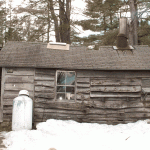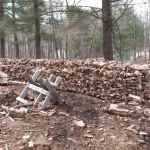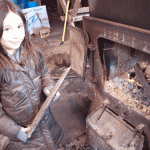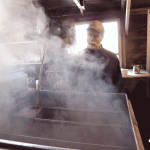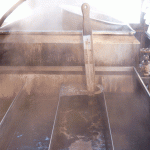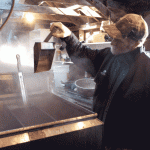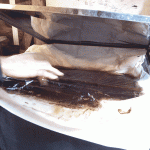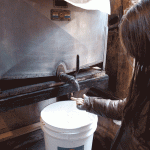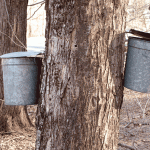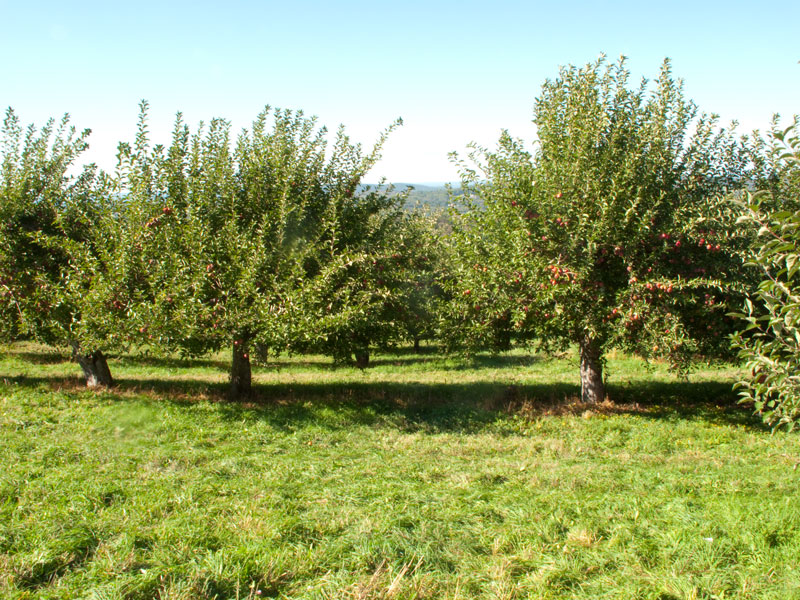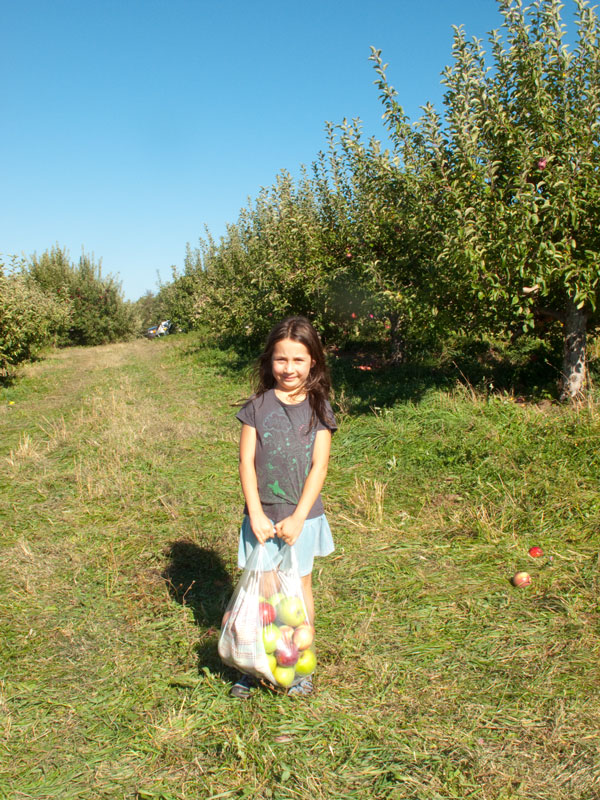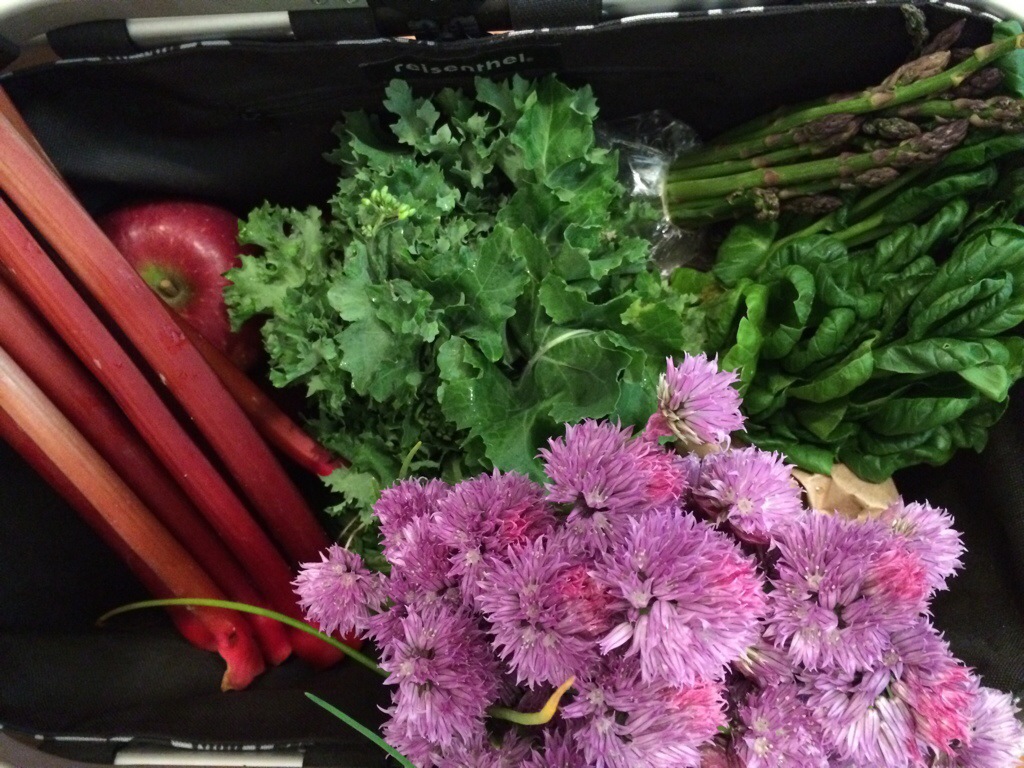
So excited!! Our weekly fruit and veggie share began today. After getting apologetic notes from both of our farmers about the rough winter, I wasn’t expecting much. It was a pleasant surprise to get such bounty. Rhubarb, apples, asparagus, flowering chives, tatsoi, dried black beans and kale rabe and Jerusalem artichokes. Time for more creative cooking!
Category Archives: Farms
Our first CSA pick-up of the year
So excited to get our first CSA share of the year. Things start as a trickle, and then in a few weeks, we hardly have space to store everything. 
The strawberries were so good, we gobbled them up.
I made the rhubarb into a delicious frozen yogurt torte. Recipe here. I think we’re getting more this week, so I think a pie will be in order.
These radishes were made into quick pickles.
Recipe:
- 1 bunch red radishes (about 13 radishes)
- 1/2 cup red wine vinegar
- 1/4 cup granulated sugar
- 1/4 cup water
- 2 teaspoons kosher salt
Heat the sugar and salt in the vinegar & water until it dissolves. While it’s cooling, slice the radishes. Add the radishes and leave in the fridge overnight. They make a really nice addition to hors d’oeuvres or a cheese plate. Don’t be alarmed by the smell when you open the jar. The pickles are delicious.
The chard was immediately sautéed with garlic and olive oil.
I made a potato leek soup with these gorgeous tender leeks.
And with all the crazy rain we’ve been getting, I noticed these mushrooms popping up in my garden. They are called Dead Man’s Fingers. Euw.
The Dirty Life
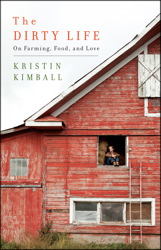
Do you ever read a book so good that you can’t put it down? But then when you get to towards the end, you want to prolong it and make it last? And when you are finished, you feel a little lost because you don’t have another book lined up that is as good as the one you just read? The Dirty Life is one of those great books. The author Kristin Kimball writes about her experience of leaving her life in New York City to start a farm. She doesn’t leave out the hard work involved, which I think makes it more realistic and compelling.
I don’t want to say more about it. Just give it a hearty recommendation.
And now I need a recommendation for a good book to fill the void.
Our First CSA Pick Up

This week was the first week of our CSA or farm share. CSA stands for Community Supported Agriculture. It’s also known as subscription farming.
In the winter, you buy a share of a farm and in return, you get a share of the produce. What’s great for the farmer, is that the payments come all at once (and are predictable), so they can purchase equipment, seeds and supplies for the next growing season. You and the farmer share the risk of a bad year, or the bounty of an excellent growing year.
What I like is that you get to relearn how to eat with the seasons. The beginning of the season has lots of greens. We got lettuce, oregano, leeks, sunchokes, and lots and lots of strawberries. I wish I could describe how aromatic and delicious these strawberries are. Everything is picked when it’s ripe because it doesn’t have to travel thousands of miles. Can you remember the insides of strawberries being red instead of white?
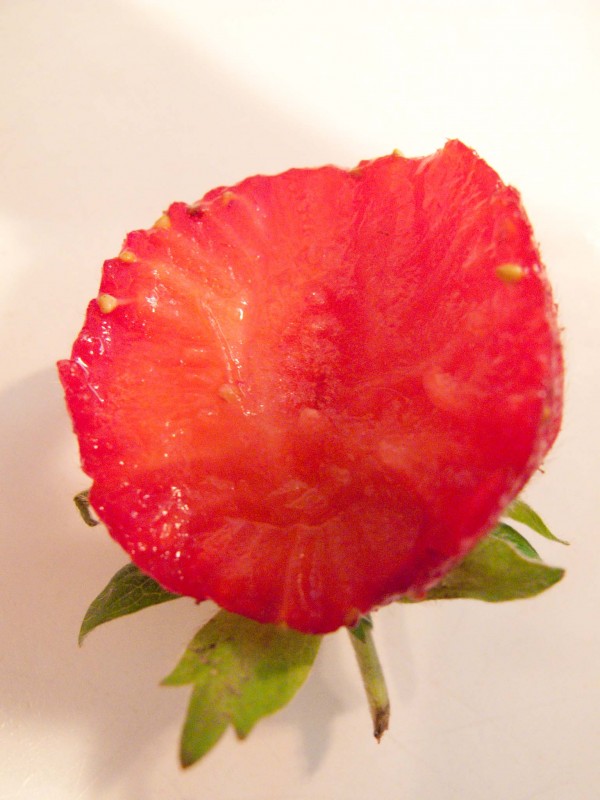
If you live in New York and are interested in participating in a CSA (for next season), click here to find one. We kind of got in through the back door with ours. It has a really long waiting list, but they offer a winter share with frozen fruits and veggies. Somehow participating in the winter share got us in and past the people lined up for just the regular summer share. Shh, don’t tell anyone.
Maple Sugaring
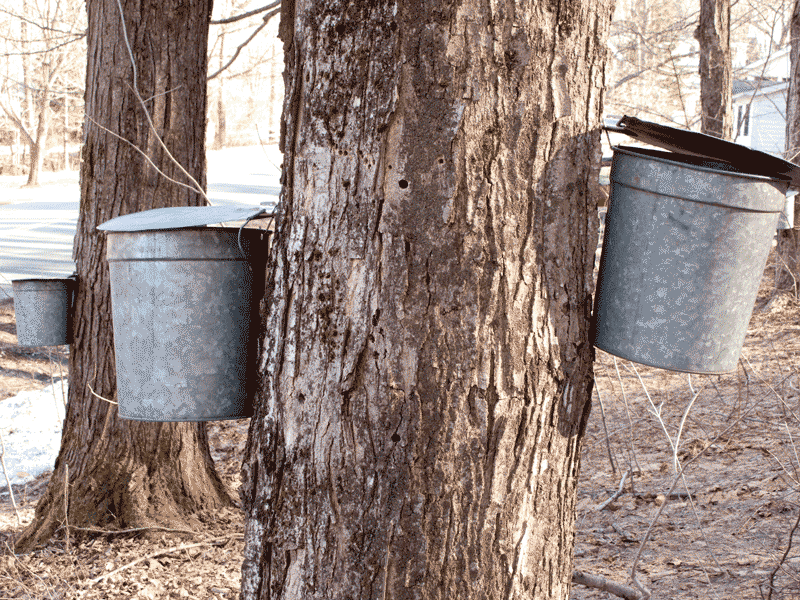
While we were up in the Berkshires, we went to visit Gould Farm to see their maple sugar operation. My in-laws recently met a man named Steve who oversees the maple sugaring there. Gould farm is a pretty amazing place. It is a residential, therapeutic community dedicated to helping adults with mental illness. You can read more about them here.
The evaporator that we saw is powered by a wood fire. From the enormous woodpile behind the sugar shack, it was clear that a lot of wood is needed for the process.
The sap is poured into the far end of the evaporator and works its way through channels. What you can’t see, is that the underside of these channels are shaped a bit like an accordion, so a very large surface area gets heated by the fire. The tree sap ranges from about 2% to 5% sugar and when it’s finished it’s about 67% sugar. We were treated to maple tea, which is the sap that has cooked for quite a bit, but is still in the back half of the evaporator. It is sweet, but still thin like tea. As an extra treat, Steve brought fresh cream from their cows to add to it, which made it taste like ice cream.
There are various ways to know when the maple syrup is finished. You can use a hydrometer, a candy thermometer (it’s ready at about 7 degrees F above the temp of boiling water), or you can do a visual check. The syrup sheets off the ladle in a manner similar to making jam. It is something you can do at home, but we were warned that with the amount of steam that is produced, many homes have lost their wallpaper during the process.
The final syrup was temporarily put in large containers, to be bottled and ready for sale in a couple of weeks. We are definitely going back to get a bottle!
- The sugar house
- Vast amounts of wood needed to make maple syrup
- Stoking the fire
- Steve in front of the evaporator
- The syrup moves through channels
- Drinking maple tea
- Testing the consistency of the syrup
- The syrup goes through a double filter when it’s finished
- Enjoying the syrup, drip by drip
Obama and Slow Food
Here is a clip of Obama answering a question posed by Slow Food USA.
Ted Talks – Birke Baehr
Why is it that an 11 year-old boy can clearly see what is wrong with our food system, but most grown-ups can’t? Watch this. It’s pretty great.
Apple Picking
This is the time of year that many urbanites decide they need to drive out to the country and pick apples. Give me the smallest excuse to get some fresh air and see something green and I will take it. The fresh air and apples sang its siren song and off I went with Lindsay and my friend Victoria and her son Theo.
It was a gorgeous, warm day at Masker Orchard, with no hint of autumn in the air (which felt a bit odd for picking apples). We decided to skip past the red delicious apples in search of the mutzus, empires and cortlands. As it turns out, a freshly picked red delicious apple bears no resemblance to the mealy ones in the grocery store. The orchard charged by the bag, so we stuffed ours ridiculously full. Lindsay and Theo had a system set up where Theo would climb in the tree and pass the apples to Lindsay. She would then inspect them and then hand the good ones off to me and Victoria. It was so much fun that we didn’t really think about the mountain of apples building up in our bags.
It was a great day. We all ate our weight in apples and then packed our weight in apples in the back of the car and headed back to the city.
Why to eat grass-fed beef
I just watched the movie Food, inc., which I recommend to everyone. If you haven’t had the time to read Omnivore’s Dilemma, it condenses the information well. If you already know about most of the issues, as I did, it renews your commitment to buying the most local and naturally raised food available.
I was talking about the movie with a friend the other day and we were specifically talking about organic and bio-dynamically raised meat. I have to admit that this is something that I haven’t incorporated into my diet as much as I could/should. We usually order Bell and Evans or Murray’s chickens from our butcher, but have had some suspicions about the veracity of the being the real deal. (other butcher’s we’ve gotten them from have had Murray’s tags on the chickens and our butcher’s doesn’t) I bought an Eberly chicken, which Neil roasted on the bbq last night. It was flavorful and delicious. They come shrink-wrapped, so it’s impossible to substitute some factory-farmed chicken for one of theirs.
My friend mentioned a local bio-dynamic angus farm called Grazin’ Angus Acres. I am lucky enough that they come to my local farmer’s market every sunday. Below I put a blurb from their website that gives some information on why to eat grass-fed beef over corn-fed beef.
Ultimately it’s healthiest for you, the animals and the planet not to eat meat, but if that isn’t an option for you, switching to grass-fed is a much healthier and humane option.
Health Benefits of Eating Grass-Fed Beef:
Safety: Because humans are omnivores, our stomachs are highly acidic. Meanwhile, the pH of grass-fed cattle is normal. If Grass-Fed Black Angus happen to be carrying bacteria in their normal pH environment, our highly acidic stomach bath offers real protection. Contrast that with corn-fed cattle… Corn turns what is typically a normal pH environment into a highly acidic one. Consequently, corn-fed cattle often require antibiotics in the feed to keep them from being sick, which generates its own set of concerns for human health. Further, if corn-fed cattle carry bacteria (e.g. E-Coli) that is thriving in their now acidic environment, the acids in our stomachs offer little, or no, protection against it.
Omegas: Grass-fed meat has been shown to have a 60% + increase in omega-3 content, as well as a more favorable omega-6 to omega-3 ratio. Both fatty acids are essential and must be obtained from food. It is important to maintain a balance of omega-3 and omega-6 in our diets, as these two substances work together to promote health. That balance is adversely affected when cattle are fed grain. Specifically, a grass-fed diet produces a 2:1 omega 6:3 ratio. “Why should I care?” you ask…
Consider that omega-6 promotes inflammation, blood clotting, and tumor growth while omega-3 does the opposite. Dietary experts estimate that current eating habits in America lead to an omega 6:3 ratio of about 20:1. Grass-fed beef is a huge step in the right direction.
ProVitamin A / beta-carotene: Beta-carotene is a fat-soluble vitamin & antioxidant that is a safe dietary source of vitamin A. Vitamin A is important to normal vision, bone growth, reproduction, cell division and cell differentiation. Grass-fed beef has a 10-fold increase in beta-carotene levels vs. grain-fed. Taking vitamin A supplements can be dangerously toxic – but, we can eat all the beta-carotene possible and the human body will only convert the amount needed to vitamin A.
Vitamin E / alpha-tocopherol: Vitamin E is also a fat-soluble vitamin / antioxidant that protects cells from the effects of free radicals (which have been reported to contribute to cancer and cardiovascular disease development). Grass-fed beef increases alpha-tocopherol levels three-fold vs. grain-fed beef.
Conjugated Linoleic Acid (CLA): Numerous health benefits have been attributed to CLA including reduced carcinogenesis, atherosclerosis, onset of diabetes and body mass. Grass-fed cattle have been shown to produce 2 to 3 times more CLA than grain-fed cattle.
IT’S NATURAL! Nature had it right all along. The sun’s energy grows the grass that is harvested by the cattle that are harvested by us. Grass-fed is how it was meant to be; it’s how our human construct was prepared to capture the nutritional value of meat. The industrial machine – feeding cattle corn in confined areas – has destroyed what nature intended.
Begin to enjoy the benefits of local Grass-Fed Black Angus today!
Chicken Meet up at the Waterpod
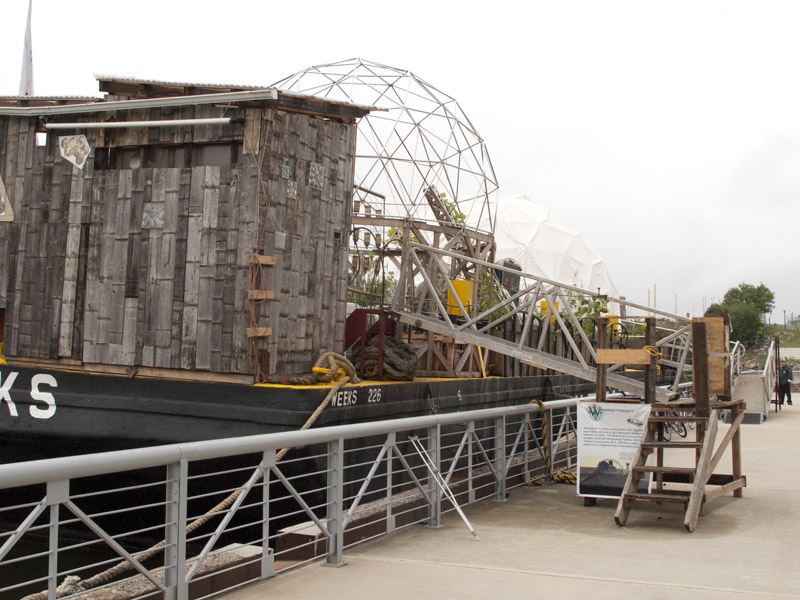
Last Saturday after going to the Greenpoint Food Market, we drove to the Bronx to go to a chicken meet up group being held on the Waterpod. KayCee Wimbush of Awesome Farm in Tivoli, NY came to talk about basic chicken keeping. Her farm pasture-raises chickens and lambs and are committed to taking care of both their animals and the land. While I knew most of the basic information, she did talk about alternatives to chicken feed.
In an attempt to reduce their feed costs and do some recycling, they gathered food scraps from local restaurants. Chickens are omnivores, or miniature goats as I like to call them, so they eat practically everything. Her solution was a win-win in that her chickens were getting high-quality food, she was saving money and the food wasn’t going to a landfill. I guess that’s a win-win-win. Anyway, these things always turn out too good to be true and they found out that what they were doing was illegal. Turns out there’s a law against feeding post-consumer food to agricultural animals. I’m sure I’m not quoting the law correctly, but it’s a way to prevent farmers from feeding ground up animals to their livestock, which can lead to many nasty diseases such as mad cow. Anyway, while it was a great idea, they had to stop.
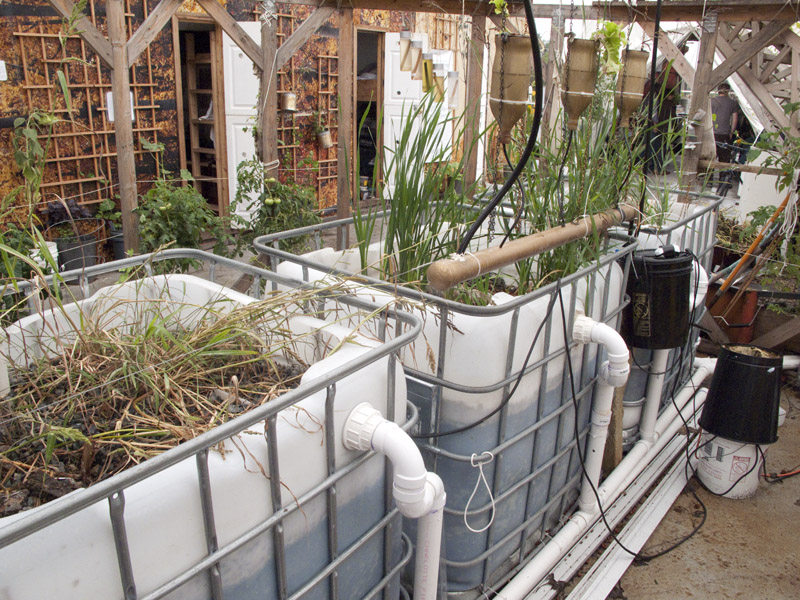
If you are in NYC in the next 2 weeks, you should try and visit the Waterpod project. They are a self-sufficient floating farm. They incorporate many interesting ideas for farming, such as vertical farming, mobile farming, recycling graywater, etc. They are showcasing a new type of farming in a time of global warming and overpopulation. If land is too scarce, you can farm on a big barge. They are open to the public for tours and host performances and discussions. They were a great venue for our meeting and even have a few hens onboard.
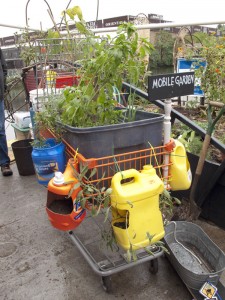
We had our meet up under one of their domes. All of the materials have been gathered from salvaged parts. The dome was covered with billboard material (is it fabric, paper??). You can see a watch ad behind Owen, who’s the organizer of our meet up group. If you can’t visit the waterpod, check out their website at the link above. It’s a very interesting project and definitely applies to urban gardening.






